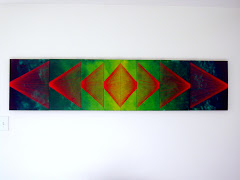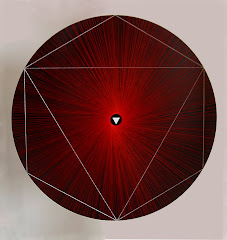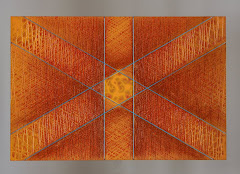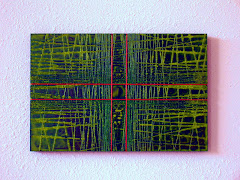I know I said I was going to focus on the visual arts in this discussion, but now I must divert your attention to the musical arts, for it is here that some of the truly great works of Western Art arose - and I'm not talking American Idol! No, we need to go back a couple of centuries to the extraordinary music of Beethoven, and in particular to the composition I alluded to in a previous blog entry - Opus 111, his last piano sonata written only a few years before his death at the age of 56. A truly astonishing piece, and one that has a curious clue locked within its form, a clue that opens a door to meaning and intention within the work. And in this lies a clue to how the Formalist School, with its dry and materialist oriented "it" perspective, can be useful.
So what is the most obvious form that this sonata takes? Why, it's the sonata form, of course! And what is the sonata form? The form itself is very simple and general, consisting of 3 movements usually broken down like this - first movement, fast and energizing and gets-you-hoppin-in-your-seat; second movement, slow and introspective or romantic (sometimes downright schmaltzy); third movement, even faster and makes-you-wanna-run-outside-and-dance-in-the-streets. Composers adopted this form because it was popular and accessible and, heck, you gotta have some kinda form! And besides, it covers the basics - fast, slow, faster. And it's versatile in that it can be applied to any solo intrument or ensemble of instruments. Mozart was a wizard with the sonata form, but it was Beethoven who truly stretched it to its limits, and beyond.
(An aside.... one of Beethoven's most popular compositions in his time was his "Emperor Concerto", a concerto consisting of a solo piano accompanied by full orchestra. At the time Europe was emerging from the bloody chaos of the French Revolution, Napolean having managed to bring a semblance of order to the trauamatized French nation, allowing its neighbors a sigh of relief. Beethoven, like many, saw Napolean as a great hero, and dedicated this work to him - thus, the "Emperer Concerto". The form of the concerto was the sonata form with its typical three movements - fast, slow, faster. The premiere performance was given in the general atmosphere of exuberance and celebration at Napolean's feats, and indeed the third movement was not only faster, but literally got the crowd in attendance dashing out into the streets dancing and screaming WOOOOOOOOOOOOOHOOOOOOOOOOO!!!!!!!!!! Later, when Napolean showed his true colors and became a dictator, Beethoven had the dedication removed from the transcript, but it was too late and the title stuck in the popular mind.)
So now, back to Opus 111...solo piano, the first movement is not only fast, it crashes down on you
like an avalanche. Think of an early nineteenth century version of a punk rock concert, the kind of music that has you hopping crazily, your head pounding up and down and eliciting an urge to dive headfirst into a crowd (with elegance of course; it is the nineteenth century after all). This is the music of a man with a mission, and with lots of anger fueling it. It's relentless, driving, unstoppable.... and it doesn't let up, slowing down just a tad only to gather itself for the next wave of hurtling energy that snatches you up and flings you like a bug. Ten minutes it goes without rest...and then, it suddenly winds down and drops you gently at your table, slumped in your seat breathing hard, sweat soaked and exhausted.
It's in that altered state created by the trauma of the first movement that Beethoven knows he truly has you at his mercy, for now, after a few silent moments, the sweetest, most angelic tune you've ever heard ripples gently into your consciousness, and an involuntary shiver of happiness nestles into a soft smile. The music is slow, it's easy, it's like being rocked by your mother. It's an aria, literally a song, a lullaby, indescribably comforting. The second movement has begun, and the form Beethoven will take here is that of the theme and variations, much as contemporary jazz musicians might improvise variation on a popular tune. From this lovely lullaby he moves into a lilting gait, a whistling stroll on a country path, then to a skipping frolic, then a mad exuberant laughing dash down that very path...and then, we are no longer running, we've lifted off the ground into the air, dipping and spinning and swooping with impossible freedom, pure joy in flight....and then....this is indescribable, but the music suddenly transforms and now we're in the heavens, the celestial sphere, weightless, out of body, and we're listening to the whispers of eternity, and we are no longer our solid body, our petty fears and anxieties and ambitions and plots and anger and sorrow....and then, we are not listening to eternity, we are eternity.....
And then...the music brings us back, back in our bodies, nestled in our mother's arms, in the arms of this manifest, lovely, wonderful world, and the aria returns, repeating itself in that original moment, until it simply...ends.....with a heavenly radiance and the softest earthly smile.
And that's the end of the sonata. No third movement, no dancing in the streets. Beethoven sent the manuscript to his publisher, who promptly sent it back, asking how he had so stupidly forgotten to include the third movement in the envelope. Beethoven simply replied, it's finished. That's it. Finito. And that was his last piano sonata. And that was the end, for all intents and purposes, of the sonata form.
So what does Beethoven's use of form tell us? It tells us exactly what he told the publisher - there is no need for a third movement, there is no need to dance in the streets, there is no need to blindly follow the convention of form, or of expectation, or of whatever you think you want to happen. In that incredible second movement he said it all, and shut up.
Tuesday, January 11, 2011
Subscribe to:
Post Comments (Atom)





.jpg)
No comments:
Post a Comment